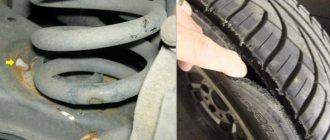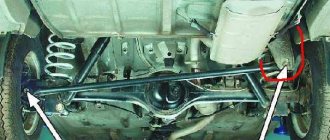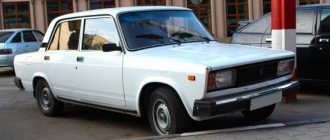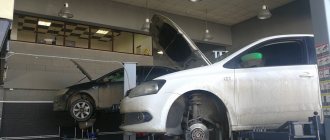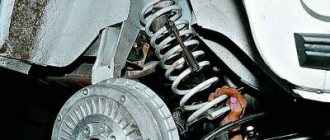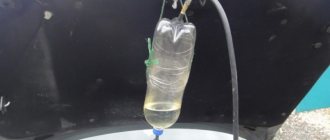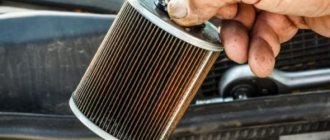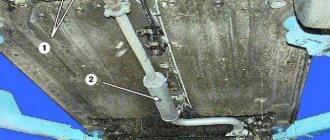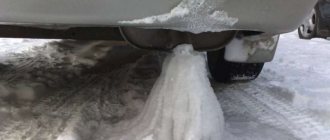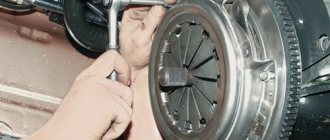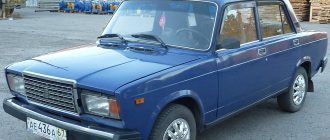The shock-absorbing system of a car is important for comfortable movement. It ensures a smooth ride and successfully absorbs uneven road surfaces. The quality of the suspension largely depends on the condition of the springs. The slightest wear of elements can cause a lot of trouble for the owner. Therefore, it is recommended to carry out timely diagnostics and replacement of old parts.
VAZ passenger cars are equipped with an independent double-wishbone suspension at the front, where springs play a key role. The famous “seven” also requires periodic maintenance of its moving parts. We will discuss further technical diagnostics and repair of the front suspension for the VAZ-2107 model.
Problems with front springs
The springs on the VAZ front suspension are located in the front part of the car on the sides of the engine compartment. Their main task is to “absorb” road imperfections. With prolonged use, parts inevitably wear out and require immediate intervention by a mechanic. Atypical behavior of the car indicates an imminent breakdown. If the car body sags significantly compared to the initial condition of the car, this is a sure sign of wear and tear. Trouble does not come alone, so as a result of body roll, accompanying troubles emerge:
- Drastic reduction in ground clearance
- Increased tire wear
- Rapid failure of other suspension elements
- The muffler and driveshaft periodically cling to the road surface
- The body sways intensely when moving
Causes of failure of front suspension springs
The warranty period for standard suspension elements is 5 years. However, actual operating conditions are very different from ideal factory tests. The reason for this is the deplorable state of domestic roads and frequent transitions to different road surfaces.
Therefore, professional drivers advise changing components at least once every 3 years or after 30,000 km of travel.
Front suspension failure occurs for several main reasons:
- Late diagnosis and replacement of consumables
- Defective part
- Driving on poor quality roads
When identifying the first “symptoms” of the disease, it is better to eliminate the problem immediately. Constantly postponing repairs can lead to breakdown of other elements of the car, which will cost the car owner a significant amount of money.
Design Features
When replacing VAZ springs, some motorists try to choose long or short copies. The degree of development is different for everyone, so some individuals, without going into details, simply cut the springs, shortening them by several turns. Of course, this is wrong - the operation of the entire suspension is immediately disrupted. This affects the functioning of the shock absorber, even the ease of control.
The service life of suspension elements is significantly reduced. But installing extended springs will not give the car any advantages. It is reasonable to do this only in cases where the car is operated in extreme conditions and its suspension is constantly loaded. During operation, even steel springs sag, which affects the ease of control. Therefore, sometimes it is necessary to diagnose the suspension and replace worn parts.
Signs of spring replacement
There are 3 main signs that indicate problems with the front springs. The presence of any of them or a combination of several indicate one thing - not everything is in order with the car.
Rolling the car to one side
To check the car for the presence of this defect, it is enough to place the vehicle on a flat surface without additional cargo inside. The unnatural skew of the car instantly catches your eye. If the body “leans” heavily on the left or right side, the front springs on the VAZ 2107 need to be replaced. A similar situation concerns an excessive slope on the front or rear axle.
But you definitely shouldn’t blame them alone, and here’s why. The design features of the suspension of VAZ cars from the “kopek” to the “seven” include a landing part in the upper part of the spring (popularly it is nicknamed “glass”). It acts as a top stop. During long-term operation of the vehicle, the glass tends to “fall through”. Externally, the body tilts to one side. The cause of the problem can only be diagnosed by removing the rubber cushion and glass. Typically, the failure of the glass occurs on the front springs, and especially often on the left wheel.
Extraneous noise in the suspension
A breakdown can be signaled by extraneous sounds, the source of which is located in the suspension area. This may include an obvious rattling or clanging sound, or a subtle knocking or grinding noise. Noises occur when the car drives on uneven sections of the road. For example, when hitting a bump or a wheel falling into a hole.
If atypical sounds are detected, a complete diagnosis of the vehicle's suspension and steering should be carried out. The source of the noise may be a ball joint, tie rods, or worn rubber gaskets. If everything is fine with them, the reason lies in the malfunction of the springs.
Extraneous sounds often indicate a split in a certain location. But sometimes the part breaks exactly in two. Then the car body looks skewed to the “sore spot”.
Metal fatigue
Auto mechanics often say that metal is “tired.” What does it mean? Metal fatigue means the loss of its initial properties due to prolonged use. Over time, the element copes worse with its assigned responsibilities.
Several extreme turns on both sides of the part fall into the risk zone, since they bear the main load. At the moment of compression, the rings are pressed tightly and hit each other. After some time, mining areas appear at the contact points of the rings. There is a transformation of the round rod, which gradually takes on a flattened shape.
A spring with a defect does not fully respond to road unevenness, and the suspension gently “sags.” If such a malfunction is detected, it is recommended to replace the part with a new one.
How to change rear springs?
In order for the repair to be as effective as possible, it is necessary to diagnose the rear suspension elements.
If there are also breakdowns there, then it is necessary to carry out repairs. Replacing springs on the rear suspension is much easier. Here is a brief description of the work being carried out:
- Place the car on a jack and remove the wheels.
- Unscrew the rod that fits the brake adjuster.
- Remove the tee mounting bracket.
- Unscrew the shock absorber mount from below.
- Unscrew the nut on the top of the shock absorber.
After all these manipulations, it is necessary to install new springs in the reverse order. Be sure to compress the springs with zip ties to make removal easier. In advance, preferably several hours in advance, treat all threaded connections without exception with penetrating lubricant.
What to look for when choosing
When choosing a new consumable, you should pay attention to key characteristics. Knowing the basic parameters will allow you to find the optimal part that suits your specific needs.
Length
The ride height depends on the length. Typically, the manufacturer mentions the recommended clearance value in the technical documentation of the model. In rare cases, the spring lengths of the rear and front axles may differ. But it is advisable not to deviate from the technical parameters from the manufacturer. These parameters are determined by precise technical calculations.
You can deviate from the recommendations in two cases:
- “pumping” the car for the sake of visual customization
- modernization of the chassis for transporting heavy loads
Rigidity
The degree of rigidity determines the behavior of the car on the road and distributes the load across the remaining suspension elements. Soft springs are suitable for comfortable, smooth rides, while hard springs cope well with high loads. Therefore, the choice of rigidity largely depends on the purpose of using the machine.
Among owners of VAZ cars (including the Seven), there is a common problem with purchasing new consumables for their “swallow”. In a single set from one manufacturer, sometimes there are elements with different degrees of rigidity. Unfortunately, it is impossible to know about this in advance, and the body defect appears during use.
To resolve the issue, car owners resort to one of two methods. The first option involves purchasing another pair, usually foreign-made. The second method involves installing spacers.
A spacer is a rubber lining that is placed under the seating area of the “glass”. This method will significantly save the budget of the owner of the Lada.
The degree of spring stiffness depends on several indicators:
- The thickness of the rod section. A simple law applies here: the thicker the rod, the higher the level of rigidity. However, there are models with different ring diameters, and therefore the rule applies only to classic straight models.
- Total diameter of turns. Increasing the width of the rings leads to increased softness.
- Number of turns. The higher the number of revolutions of the rod, the lower the rigidity of the part.
Turning parameters
The main characteristics include two indicators: the number of turns and the thickness of the section. They determine the final degree of rigidity of the part.
It is not uncommon to find original springs with different ring diameters. Externally, they have an oval shape: wide in the middle with a gradual decrease towards the edges. The different diameters of the rings are also made of metal of different thicknesses. For massive turns, a thick rod is used, and the small rings on the sides are made of thin material. This design feature gives it versatility: it dampens small vibrations and large shocks equally well.
But the main “disease” of these models is hidden in the extreme turns. Due to the small thickness of the metal, the side parts of the part are very fragile, and therefore often break on uneven roads. This is the price of comfort: for a soft ride you have to pay for frequent repairs.
An alternative to factory springs is products from third-party manufacturers. A non-original product is made from a rod with a constant cross-section. This negatively affects ride comfort due to high rigidity. But non-original consumables are distinguished by their reliability and durability.
Types
The springs of the shock-absorbing system are conventionally divided into 5 categories, which can be presented in table form:
| Variety | Characteristic |
| Standard | They come as standard equipment for the car from the manufacturer. Designed for driving on city highways and rough terrain. |
| Reinforced | Capable of withstanding heavy loads. Used for transporting heavy loads. |
| Extended | Modification to increase the vehicle's ground clearance. |
| Shortened | They have the opposite effect - reducing the vehicle's ground clearance. At the same time, controllability indicators increase significantly. |
| Variable hardness | A universal option for traveling on various road surfaces. |
Finding the optimal solution depends on the intended use of the vehicle and the manufacturer's recommendations.
The standard kit for the VAZ 2107 is original parts from a “penny”. But to improve aerodynamic performance, car owners resort to tricks. Often, instead of standard elements, spare parts from the “four” are chosen, which have a positive effect on handling. True, to install them in the “seven” you need to remove the outermost turn.
Rear shock absorbers from Niva on VAZ 2107
On sale are reinforced springs and spacers. what to prefer? VAZ-2101. 2107.
It's no secret that Zhiguli sedans, from VAZ-2101 to 2107, have a common weakness - rear suspension springs. Probably chosen for “comfort” reasons, they work acceptably when the machine is not very loaded. And under full (albeit within normal) load, they are compressed so much that on an uneven road the rear axle beam can hit the bump stops. This can also be caused by problems with the shock absorbers, especially if the car is far from new. Over time, due to changes in the structure of the metal, the stiffness of the springs also decreases - they sag, the compression stroke becomes very small, and under heavy loads almost disappears. In general, as a movie character would say, with such springs there is no life!
Placing spacers under the springs will not really solve the problem. Firstly, metal fatigue takes its toll - and one day the spring simply breaks. Secondly, frequently repeated impacts destroy the bump stops; in addition, cracks appear in body parts, especially if the spring is compressed before the coils collide. That is why the installation of rubber spacer rings, although it increases cross-country ability, is still rather self-deception.
There are also rubber inserts on sale that are designed to be installed between the coils of a weakened spring. Their main drawback is the same as that of spacers; Let's add fragility to this.
Meanwhile, springs from the VAZ-2104 station wagon are allowed to be installed on the Zhiguli sedan. These springs are 21 mm longer - hence the additional load capacity.
There is another option - however, which did not receive the go-ahead from VAZ - replacing the standard rear springs with rear springs from Niva.
The table shows the basic data of various springs.
Rear suspension springs for Zhiguli
| 434 | 127,5 | 12,4 | 9,3 | 1,85 | |
| Station wagon | 455 | 127,5 | 12,4 | 9,3 | 1,85 |
| "Niva" VAZ-2121 | 434 | 127–129 | 12,7 | 9,3 | 2,25 |
* Load required to compress the spring by 1 mm.
As can be seen from the table, with almost identical geometric dimensions, the spring stiffness of the Niva is higher than that of the classic ones by an average of 22%. The advantages of these springs are illustrated in the figure.
Changing the length of springs depending on the load.
Keep in mind: there are products on the shelves whose data, to put it mildly, do not correspond to those given in the table. They often turn out to be longer than even those intended for the VAZ-2104 and, moreover, differ in the number of turns.
When installing station wagon springs on sedans, the clearance in the rear suspension area increases by approximately 20 mm over the entire vehicle load range. Before the bump stops touch, you can load 40 more kilograms into the car than with standard springs. However, gradually the sagging of the springs will sooner or later negate this gain. (More likely, it’s too early, because the spare parts are not of high quality.)
When installing the rear springs of a Niva, the clearance on an empty car will also increase - almost the same as when installing springs from a VAZ-2104. However, with a further increase in load, the clearance will decrease significantly less. For example, before the bump stops touch the car, you can load 90 kg more than with standard springs. In addition, the amplitude of vibrations of the rear suspension will decrease - the suspension will become stiffer.
Disadvantages - increased load on the body, which can lead to premature cracks, and increased wear of standard shock absorbers during rebound. Indeed, with a heavy load and normal rebound motion, the “shot” force is much higher. And with a small load, the rebound stroke decreases - the car seems to stand on tiptoes, although the spring force is normal. If we remember the principles of suspension operation, it is clear that the “orchestra” is somewhat upset. Here the shock absorbers, in an amicable way, need different ones, with higher rebound resistance. Thus, the car enthusiast has several options to choose from.
Main types and ratings of suspension springs
How to choose the best springs for the VAZ 2107 presented on the domestic market? It is impossible to give a definite answer to the question, since each driver eventually finds “his” company, whose products he is ready to trust. A list of 14 well-known companies that have long proven themselves to be the best will help you understand the huge number of brands.
LESJOFORS
The real flagship of the industry comes from Europe. The company has been producing spare parts for car suspensions for many years. The company has a developed network of branches with representation in four European countries.
Lesjofos springs are cast from special steel with a high carbon content. A special protective coating is applied to the surface of the part and then painted. The products are distinguished by their long service life, confirmed by numerous tests. There are over 3 thousand items on the market under a well-known brand. The main disadvantage of the product is the “biting” price tag.
KILEN
At the end of the last century, the company came under the wing of “lesjofos”, and today it is a “daughter” of the giant. Accordingly, the sub-brand’s products have twice the service life compared to the original parts from the Volga plant. Car owners praise the product for its high quality combined with an adequate price.
LEMFORDER
The company is a well-known supplier of original products for many premium cars. Therefore, the price of the product is not the lowest. But in return, the buyer receives unsurpassed quality, supported by countless positive reviews.
CS GERMANY
German company producing components. The products are in the middle price category. Drivers respect the brand for the optimal ratio of cost and quality of the goods offered.
KONI
The company's products are distinguished by a large margin of safety and are widely represented on the market. The price of components is in the “above average” category. The main feature of the springs is the ability to dynamically adjust the stiffness level.
BOGE
The manufacturer produces various parts for car suspension. The manufactured products belong to the “premium” category. The cost of boge products fully corresponds to the class of the company. Manufacturing defects occur rarely; reviews from car owners are mostly positive.
EIBACH
is one of the key players in the automotive market. Its products practically do not lose their initial properties over time and are popularly considered “immortal”. The only thing that spoils the overall impression is the cost of parts from the eminent flagship of the industry, which is many times superior to its competitors.
SS20
The key feature of the manufacturer is a painstaking approach to manufacturing technology. The factory carefully selects pairs with equal hardness. Therefore, when purchasing, you can be sure that the kit is guaranteed to have similar parameters. Production technologies are based on cold and hot winding methods.
K&F
belongs to the leading manufacturers of spare parts for cars and trucks. In addition to supplying new parts, the company actively operates in the secondary market. The rich product range includes over a thousand items. Springs from a famous brand are famous for their quality, but they cost a lot of money.
TEVEMA
Polish manufacturer of shock-absorbing springs operating in the European and Asian regions. The insane demand for the company's products is dictated by the low cost of parts, which are several times cheaper than original components.
SIRIUS
The company produces products in the budget segment. A wide selection of components received positive feedback from car owners. It is especially worth noting the possibility of producing parts according to an individual sketch.
FOBOS
The company does not have enough stars in the sky, but the price tag for the products is appropriate. A small range of products with mediocre quality. Car owners note that the first defects “pop up” after just a year of active use.
ASOMI
The company is famous for its own production technologies, which are kept in the strictest confidence. "Asomi" offers high-quality products at reasonable prices.
TECHNORESSOR
An economical option for those who are broke. The company produces spare parts for cars and trucks. Springs gradually lose their initial properties. An excellent solution for economical drivers.
Spring Upgrade
The process of upgrading springs involves changing the length of the part on your own. To do this, the element is shortened or replaced with a longer sample.
Shortened springs
Drivers resort to reducing the size of a part in order to improve the characteristics of their iron comrade. Trimming the springs gives the car some advantages:
- Lowering the body position
- Better steering response
- Reduced roll when entering a turn
Many manufacturers offer a ready-made solution in the form of special versions of short springs. However, it is worth remembering that after tuning the ground clearance will decrease significantly. Such a “seven” will not be able to drive on uneven roads.
You can lower the “seven” yourself. To do this, you need to cut 2 turns from each spring using a grinder.
It is not recommended to cut off more rings, because the body will touch the ground.
Video: cutting springs on a classic
The video shows working with a VAZ 2106, but the technological process for the “Seven” is completely identical.
Link to video:
Spacers for springs
Even the most innovative springs gradually exhaust their service life. And the owner is faced with a choice: replace the part with a new one or extend the life of the element with the help of a spacer.
The spacer for the VAZ 2107 has several varieties:
- Interturn (attached between the rings)
- Butt (between the spring and the cup)
- Suspension spacer
An interturn spacer is suitable for spring repair. You can buy it at a VAZ car parts store. Installation is performed in the following sequence:
- Raise the wheel with a jack
- Unclench the required coils of the spring with crowbars
- Soak the spacer with soapy water
- Insert the spacer with a screwdriver and secure it
- Remove the jack from under the wheel
- Repeat all steps on the other wheel
Video: operating procedure
You can view the video material at the link:
Replacing the lower front suspension arm on VAZ-2101, VAZ-2102, VAZ-2104, VAZ-2 cars
The lower lever on VAZ-2101, VAZ-2102, VAZ-2104, VAZ-2105, VAZ-2106, VAZ-2107, Zhiguli cars must be changed if: the lever is bent or cracks are found on it (it is not recommended to cook the lever), the silent blocks rotate lugs. This work cannot be called easy. But it also cannot be called unfeasible. In order to replace the lever with your own hands, you first need to think about the tool, and then about spare parts. And it is not just words. For example: to remove the lever you will need a spring puller. Without it, you may not only fail to put the spring back in place (let’s say you managed to remove it painlessly), but also get serious injuries. Also, I would like to remember about the ball joint remover and the device for pressing in and pressing out silent blocks. In principle, the last point can be excluded, but only if you purchase a lower lever assembly (a lever with a lower axle and silent blocks). But this option has a small disadvantage - the price. Although, what am I going to tell you when you can visit the market yourself and decide what will be easier and more profitable for you.
Let's get down to business. You can see the tension puller for springs and the puller for ball joints in photo 1. You can see the devices for pressing silent blocks and understand how to work with them by reading this article. What’s next... On the tool. I will not make a detailed list, I will list it in an abbreviated version - open-end and ring wrenches (13, 17, 19, 22), a pry bar, a hammer and a chisel. And a special key for fixing the front shock absorber rod will also be useful in this work, photo 2. Spare parts. If you nevertheless bought a lever assembly for your beloved Classic, then you have almost nothing to worry about. If not, then let's look at what else you should buy (besides the lever). First, two silent blocks for the lower arm (if you are going to change both levers, right and left, you will have to buy four silent blocks). Two thrust washers (internal) on the axis of the lower arm. The axle itself can also present a surprise, so we can also advise you to buy it (I had it, “just in case”), along with thrust washers and nuts - photo 3). Looking ahead, I will say that in my case the axis was not useful. Only the thrust washers were used. Now, as always, a point-by-point description of replacing the lower front suspension arm on a VAZ-2101, VAZ-2102, VAZ-2104, VAZ-2105, VAZ-2106, VAZ-2107, Zhiguli car: 1. Jack up the required side and remove the wheel.2. We remove the front shock absorber - photos 4 and 5.3. We install a tension puller into the spring (preferably grab 5 turns) and compress it - photo 6, 7, 8.4. Now you can unscrew the anti-roll bar bracket, unscrew the lower ball joint nut and unpress the ball pin - photo 9, 10.5. Push the lever down and remove the spring (photo 11).6. Unscrew (19mm wrench) the two nuts securing the lower arm to the beam (photo 12). And remove the lever. It may not be possible to remove the lever right away. And to fix this, you will have to pick up a chisel, a hammer and a pry bar. We hammer the chisel between the lever axis and the beam, which will allow you to tear the stuck axis off the bolts. Yes, and we try not to lose the adjusting washers (photo 13) and remember on which side how many washers there were.7. The lever has been removed. Next, if the lever is assembled, we put it on the car. If not, then press the removed lever in order to get the axle (photo 14). After that, we assemble the lever - installing the axle and silent blocks. Photos - 15, 16, 17, 18, were taken on a different day and with a different lever, but I think they will still be useful to you. 8. That's all. From the side we do it in the reverse order. Before assembly, lubricate the bolts of the beam and the axle journal, for example, with nigrol. Lastly, we tighten the nuts (22mm wrench) of the lower arm axle, with the car completely lowered to the ground (this is necessary for the silent blocks to work correctly). Well, it looks like I haven’t forgotten anything! )))
